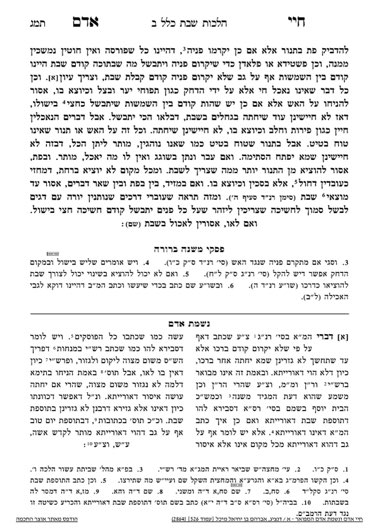We have finished siman 3. We pointed out that the Chayei Adam does not discuss the solution of covering over the coals or knobs. This solution is discussed in the Gemara, and is known as gerufah u’ketumah. When one leaves food on the fire, there is concern one may stir the coals. But if one does something to change the fire, the change itself should serve as the reminder and deterrent for a person to refrain from violating Shabbos.
The Gemara discusses two possibilities. The first is to sweep out the coals from inside the oven, known as gerufah. Even though there is still a certain amount of coals which will inevitably remain, since the person has performed an action to minimize the heat, we are not concerned one will perform an action to maximize the heat, as they are clearly agreeable with such an arrangement.
The second possibility is to place a layer of ash on top of the coals, known as ketumah. The ash minimizes the heat, and works with the same thought process as gerufah, as explained above.
These possibilities work both for Ashkenzaim and Sephardim. We learned (S0039) that the Shulchan Aruch holds that the food must be fully ready before Shabbos in order to avoid the issur of shehiyah. The Rema holds that as long as the food is edible (preferrably one half cooked and one third cooked in cases of necessity [S0042]), it is considered ready and there is no issur of shehiyah. According to both opinions, even if the food is not ready to its respective level, performing an act to make the oven gerufah or ketumah sufficiently avoids the concerns of the issur of shehiyah.
In our modern vernacular, this is known as a blech. The blech is a sheet of metal which serves to cover the “coals” (i.e., the open flame of a stove) by covering over the source of the heat. We cannot approximate gerufah, because it is not possible to remove the source of heat, but it is the equivalent of ketumah.
The Chazon Ish is of the opinion that a blech only serves to make the fire ketumah if it diminishes the heat. If so, a simple blech, which is a good conductor of heat, is not sufficient. A person would have to have a blech with height to it so it allows for heat to escape and minimizes the heat transferring to the food. Rav Moshe, among others, assumes that a simple blech is sufficient. They hold that the primary objective is for the blech to serve as a reminder that one should not rake the coals/change the knobs, so even a simple blech serves as such a reminder.
Rav Moshe points out that if a person decides that the blech is helpful for cooking, and cooks throughout the week with the blech over the fire, they have removed the reminder served by the blech, and their blech would not be valid.
Rav Moshe adds that since nowadays, the primary concern is that one will change the temperature knobs, one should cover the knobs as well. However, he agrees that the primary reminder as established by Chazal for refraining from manipulating the temperature is to cover the fire itself. Thus, in a situation in which one’s food is not cooked enough, they may leave their food on a blech and they have avoided the issur of shehiyah.
We will discuss whether a blech is necessary when the food is minimally edible (i.e., has just passed the threshold at the onset of Shabbos) in the upcoming shiur, be’ezras Hashem.
Summary
- Even when food is not cooked sufficiently to remain on the fire at the onset of Shabbos, one solution to avoid the issur of shehiyah is to make the fire gerufah or ketumah.
- The modern application of ketumah is a blech, which serves to cover the source of heat.
- The Chazon Ish held that the blech must have height to it, in order to allow for heat to escape. However, Rav Moshe, and others, held this is not necessary.
- Rav Moshe holds that since the primary method nowadays for manipulating the temperature of a fire is the knobs or dials, they should be covered.



